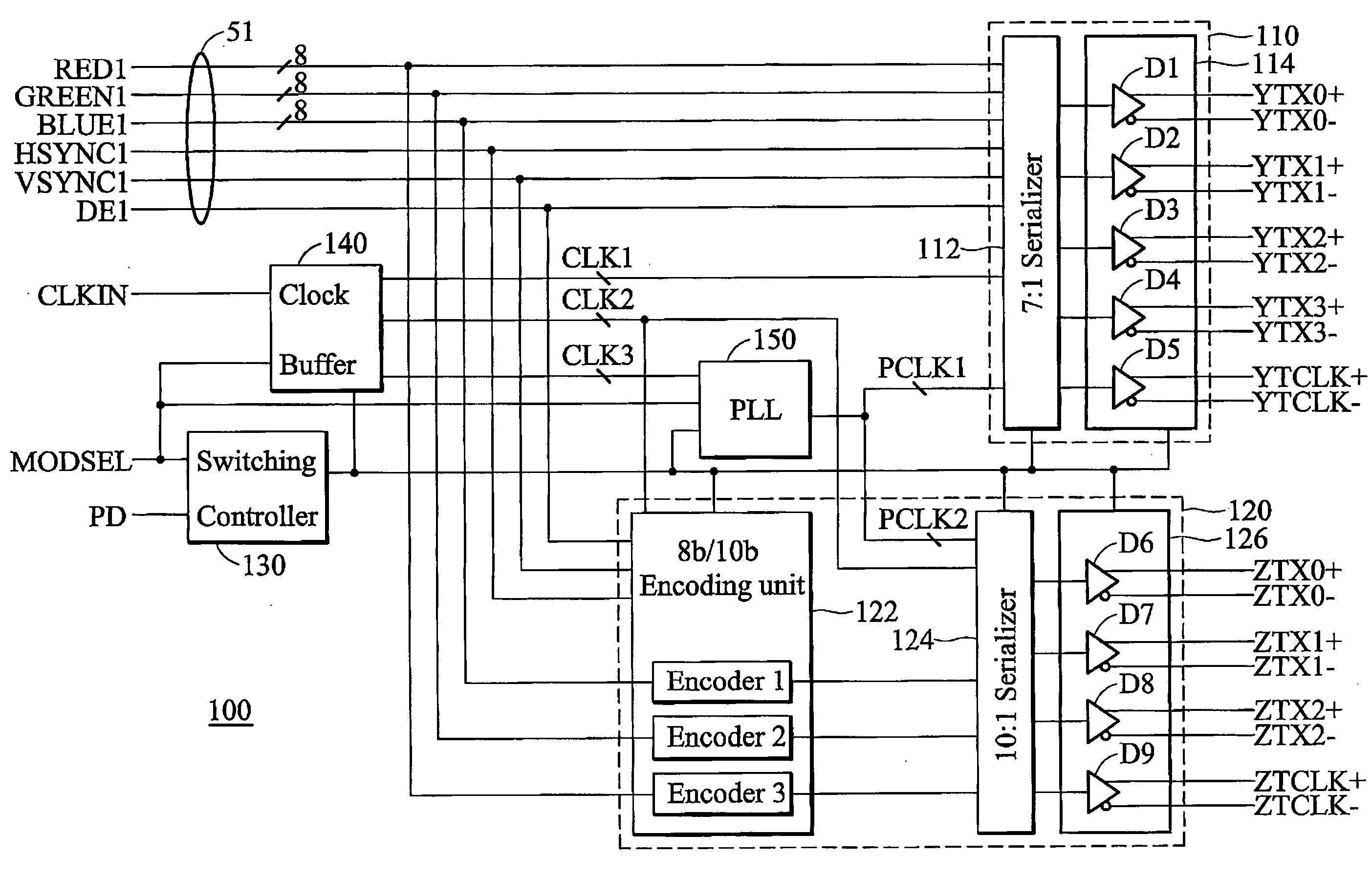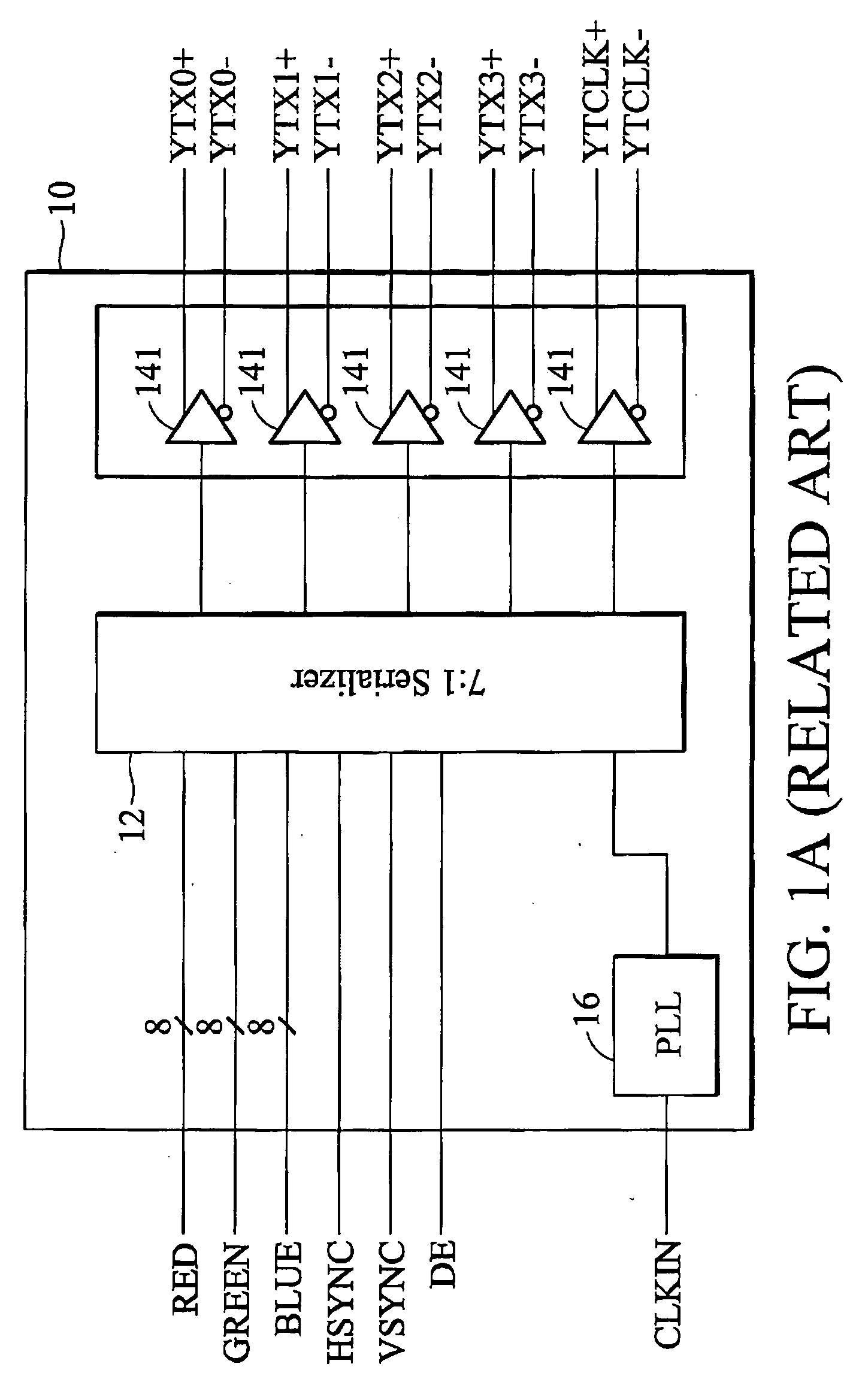Combined transmitter
a transmitter and receiver technology, applied in the field of transmitters, can solve problems such as failure of the transfer lvds technology to external desktop monitors
- Summary
- Abstract
- Description
- Claims
- Application Information
AI Technical Summary
Benefits of technology
Problems solved by technology
Method used
Image
Examples
first embodiment
[0029]FIG. 3A is a schematic diagram of a combined transmitter capable of transmitting LVDS signals and TMDS signals according to a first embodiment of the invention. As shown in FIG. 3A, the combined transmitter 100 comprises a first set of input terminals 51, a first transmission unit 110, a second transmission unit 120, a switching controller 130, a clock buffer 140 and a phase locked loop (PLL) 150. The set of input terminal 51 receives first data comprising video and sync information (RED1, GREEN1, BULE1, HSYNC1, VSYNC1 and DE1).
[0030] The first transmission unit 110 can be a LVDS transmitter as shown in FIGS. 1A and 1B. The first transmission unit 110 is coupled to the input terminals 51 to transmit first data, through the first signal lines YTX0+˜YTX3+, YTX0−˜YTX3−, YTCLK+ and YTCLK−, to a corresponding receiver (not shown). The first transmission unit 110 comprises a first serializer 112 coupled to the input terminals. 51 to convert parallel data to serial data streams and ...
second embodiment
[0046]FIG. 3B is a schematic diagram of a combined transmitter capable of transmitting LVDS signals and TMDS signals according to a second embodiment of the invention. As shown in FIG. 3B, the combined transmitter 100′ comprises a first set of input terminals 51, a first transmitter 110, a second transmitter 120, a switching controller 130, a clock buffer 140 and a phase locked loop (PLL) 150.
[0047] The combined transmitter 100′ is similar to that shown in FIG. 3A except for the driving unit 126. For brevity, description of like structures is omitted. The drivers D6˜D9 are coupled to the signal lines YTX1+˜YTX3+, YTX1−˜YTX3−, YTCLK+ and YTCLK− coupled to the driving unit 114 in the first transmission unit 110, rather than the signal lines ZTX0+˜ZTX2+, ZTX0−˜ZTX2−, ZTCLK+˜ZTCLK− as shown in FIG. 3A. The first and second transmission units 110 and 120 share the input terminals 51 and the output terminals, such as the signal lines YTX1+˜YTX3+, YTX1−˜YTX3−, YTCLK+˜YTCLK−.
[0048] In LVD...
third embodiment
[0052]FIG. 3C is a schematic diagram of a combined transmitter capable of transmitting LVDS signals and TMDS signals according to a third embodiment of the invention. As shown in FIG. 3C, the combined transmitter 100″ comprises a first set of input terminals 51, a second set of input terminals 52, a first transmitter 110, a second transmitter 120, a switching controller 130, a clock buffer 140 and a phase locked loop (PLL) 150.
[0053] The combined transmitter 100″ is similar to that in FIG. 3A except for the encoding unit 122 and the driving unit 126. For brevity, description of like structures is omitted. The second set of input terminals 52 receives second data comprising video and sync information RED2, GREEN2, BULE2, HSYNC2, VSYNC2 and DE2. The encoding unit 122 in second transmission unit 120 is coupled to the second set input terminals 52, rather than the first set of input terminals 51 as shown in FIG. 3A. Further, the drivers D6˜D9 in the second driving unit 126 are coupled ...
PUM
 Login to View More
Login to View More Abstract
Description
Claims
Application Information
 Login to View More
Login to View More - R&D
- Intellectual Property
- Life Sciences
- Materials
- Tech Scout
- Unparalleled Data Quality
- Higher Quality Content
- 60% Fewer Hallucinations
Browse by: Latest US Patents, China's latest patents, Technical Efficacy Thesaurus, Application Domain, Technology Topic, Popular Technical Reports.
© 2025 PatSnap. All rights reserved.Legal|Privacy policy|Modern Slavery Act Transparency Statement|Sitemap|About US| Contact US: help@patsnap.com



